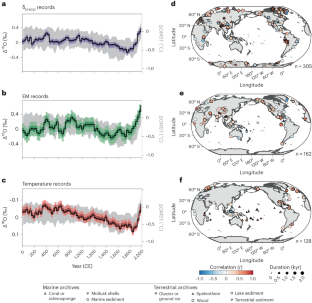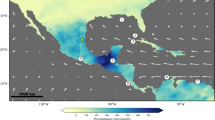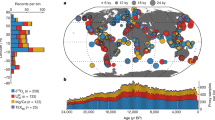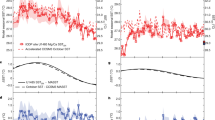Abstract
The response of the global water cycle to changes in global surface temperature remains an outstanding question in future climate projections and in past climate reconstructions. The stable hydrogen and oxygen isotope compositions of precipitation (δprecip), meteoric water (δMW) and seawater (δSW) integrate processes from microphysical to global scales and thus are uniquely positioned to track global hydroclimate variations. Here we evaluate global hydroclimate during the past 2,000 years using a globally distributed compilation of proxies for δprecip, δMW and δSW. We show that global mean surface temperature exerted a coherent influence on global δprecip and δMW throughout the past two millennia, driven by global ocean evaporation and condensation processes, with lower values during the Little Ice Age (1450–1850) and higher values after the onset of anthropogenic warming (~1850). The Pacific Walker Circulation is a predominant source of regional variability, particularly since 1850. Our results demonstrate rapid adjustments in global precipitation and atmospheric circulation patterns—within decades—as the planet warms and cools.
This is a preview of subscription content, access via your institution
Access options
Access Nature and 54 other Nature Portfolio journals
Get Nature+, our best-value online-access subscription
$29.99 / 30 days
cancel any time
Subscribe to this journal
Receive 12 print issues and online access
$259.00 per year
only $21.58 per issue
Buy this article
- Purchase on Springer Link
- Instant access to full article PDF
Prices may be subject to local taxes which are calculated during checkout



Similar content being viewed by others
Data availability
The Iso2k Database57 is available for download at https://doi.org/10.25921/57j8-vs18 and is accessible via the NOAA/WDS Paleo Data landing page at https://www.ncdc.noaa.gov/paleo/study/29593. Composites and principal component datasets generated for this paper are available through GitHub at https://github.com/nickmckay/iso2kNatureGeoscience2023 and archived via Zenodo (https://doi.org/10.5281/zenodo.8327339).
Code availability
Codes to reproduce the main results from this paper are available through GitHub at https://github.com/nickmckay/iso2kNatureGeoscience2023 and archived via Zenodo (https://doi.org/10.5281/zenodo.8327339).
References
PAGES 2k Consortium. Consistent multidecadal variability in global temperature reconstructions and simulations over the Common Era. Nat. Geosci. 12, 643–649 (2019).
PAGES 2k Consortium. A global multiproxy database for temperature reconstructions of the Common Era. Sci. Data 4, 170088 (2017).
IPCC Climate Change 2014: Impacts, Adaptation, and Vulnerability (eds Field, C. B. et al.) (Cambridge Univ. Press, 2014).
PAGES Hydro2k Consortium. Comparing proxy and model estimates of hydroclimate variability and change over the Common Era. Clim. Past 13, 1851–1900 (2017).
Rozanski, K. in Isotopes in the Water Cycle (eds Aggarwal, P. K. et al.) 291–302 (Springer, 2005).
Galewsky, J. et al. Stable isotopes in atmospheric water vapor and applications to the hydrologic cycle. Rev. Geophys. 54, 809–865 (2016).
Konecky, B. L., Noone, D. C. & Cobb, K. M. The influence of competing hydroclimate processes on stable isotope ratios in tropical rainfall. Geophys. Res. Lett. 46, 1622–1633 (2019).
Jasechko, S. Global isotope hydrogeology―review. Rev. Geophys. 57, 835–965 (2019).
Sturm, C., Zhang, Q. & Noone, D. An introduction to stable water isotopes in climate models: benefits of forward proxy modelling for paleoclimatology. Clim. Past 6, 115–129 (2010).
Gat, J. Isotope Hydrology: A Study of the Water Cycle 6 (Imperial College Press, 2010).
Bowen, G. J., Cai, Z., Fiorella, R. P. & Putman, A. L. Isotopes in the water cycle: regional- to global-scale patterns and applications. Annu. Rev. Earth Planet. Sci. 47, 453–479 (2019).
Dansgaard, W. Stable isotopes in precipitation. Tellus 16, 436–468 (1964).
Craig, H. & Gordon, L. I. in Stable Isotopes in Oceanographic Studies and Paleotemperatures (ed. Tongiorgi, E.) 9–130 (Consiglio Nazionale Delle Ricerche, Laboratorio di Geologia Nucleare-Pisa, 1965).
Rohling, E. J. in Encyclopedia of Quaternary Science 2nd edn (eds. Elias, S. A. & Mock, C. J.) 915–922 (Elsevier, 2013).
Konecky, B. L. et al. The Iso2k database: a global compilation of paleo-δ18O and δ2H records to aid understanding of Common Era climate. Earth Syst. Sci. Data 12, 2261–2288 (2020).
Urey, H. C. Oxygen isotopes in nature and in the laboratory. Science 108, 489–496 (1948).
Kaufman, D. et al. Holocene global mean surface temperature, a multi-method reconstruction approach. Sci. Data 7, 201 (2020).
Brady, E. et al. The connected isotopic water cycle in the Community Earth System Model Version 1. J. Adv. Model. Earth Syst. 11, 2547–2566 (2019).
Stevenson, S. et al. Volcanic eruption signatures in the isotope‐enabled last millennium ensemble. Paleoceanogr. Paleoclimatol. 34, 1534–1552 (2019).
Otto-Bliesner, B. L. et al. Climate variability and change since 850 CE: an ensemble approach with the Community Earth System Model. Bull. Am. Meteorol. Soc. 97, 735–754 (2016).
Thompson, D. M. et al. Identifying hydro‐sensitive coral δ18O records for improved high‐resolution temperature and salinity reconstructions. Geophys. Res. Lett. 49, e2021GL096153 (2022).
Rozanski, K., Araguás-Araguás, L. & Gonfiantini, R. in Climate Change in Continental Isotopic Records (eds Stewart, P. K. et al.) 1–36 (American Geophysical Union, 1993).
Petit, J. R. et al. Climate and atmospheric history of the past 420,000 years from the Vostok ice core, Antarctica. Nature 399, 429–436 (1999).
Guan, J. et al. Understanding the temporal slope of the temperature‐water isotope relation during the deglaciation using isoCAM3: the slope equation. J. Geophys. Res. 121, 10,342–10,354 (2016).
Siler, N. et al. The large-scale, long-term coupling of temperature, hydrology, and water isotopes.J. Clim. 34, 6725–6742 (2021).
Falster, G., Konecky, B., Madhavan, M., Stevenson, S. & Coats, S. Imprint of the Pacific Walker Circulation in global precipitation δ18O. J. Clim. 34, 8579–8597 (2021).
Putman, A. L., Bowen, G. J. & Strong, C. Local and regional modes of hydroclimatic change expressed in modern multidecadal precipitation oxygen isotope trends. Geophys. Res. Lett. 48, e2020GL092006 (2021).
Majoube, M. Fractionnement en oxygene 18 et en deuterium entre l’eau et sa vapeur. J. Chim. Phys. 68, 1423–1436 (1971).
Craig, H., Gordon, L. I. & Horibe, Y. Isotopic exchange effects in the evaporation of water: 1. low‐temperature experimental results. J. Geophys. Res. C 68, 5079–5087 (1963).
Horita, J., Rozanski, K. & Cohen, S. Isotope effects in the evaporation of water: a status report of the Craig–Gordon model. Isotopes Environ. Health Stud. 44, 23–49 (2008).
Nusbaumer, J., Wong, T. E., Bardeen, C. & Noone, D. Evaluating hydrological processes in the Community Atmosphere Model Version 5 (CAM5) using stable isotope ratios of water. J. Adv. Model. Earth Syst. 9, 949–977 (2017).
Aggarwal, P. K. et al. Stable isotopes in global precipitation: a unified interpretation based on atmospheric moisture residence time. Geophys. Res. Lett. 39, L11705 (2012).
Held, I. M. & Soden, B. J. Robust responses of the hydrological cycle to global warming. J. Clim. 19, 5686–5699 (2006).
Gat, J. R., Mook, W. G. & Meijer, H. A. Environmental Isotopes in the Hydrological Cycle 2nd edn (International Atomic Energy Agency, 2001).
Bailey, A., Posmentier, E. & Feng, X. Patterns of evaporation and precipitation drive global isotopic changes in atmospheric moisture. Geophys. Res. Lett. 45, 7093–7101 (2018).
Neukom, R., Steiger, N., Gómez-Navarro, J. J., Wang, J. & Werner, J. P. No evidence for globally coherent warm and cold periods over the preindustrial Common Era. Nature 571, 550–554 (2019).
Stuiver, M., Grootes, P. M. & Braziunas, T. F. The GISP2 δ18O climate record of the past 16,500 years and the role of the sun, ocean, and volcanoes. Quat. Res. 44, 341–354 (1995).
Vuille, M. et al. A review of the South American monsoon history as recorded in stable isotopic proxies over the past two millennia. Clim. Past 8, 1309–1321 (2012).
Zhao, K. et al. A high-resolved record of the Asian summer monsoon from Dongge Cave, China for the past 1,200 years. Quat. Sci. Rev. 122, 250–257 (2015).
Konecky, B. L. et al. Intensification of southwestern Indonesian rainfall over the past millennium. Geophys. Res. Lett. 40, 386–391 (2013).
Cook, E. R., Seager, R., Cane, M. A. & Stahle, D. W. North American drought: reconstructions, causes, and consequences. Earth Sci. Rev. 81, 93–134 (2007).
Shuman, B. N. et al. Placing the Common Era in a Holocene context: millennial to centennial patterns and trends in the hydroclimate of North America over the past 2,000 years. Clim. Past 14, 665–686 (2018).
Li, J., Xie, S.-P. & Cook, E. R. El Niño phases embedded in Asian and North American drought reconstructions. Quat. Sci. Rev. 85, 20–34 (2014).
Bjerknes, J. Atmospheric teleconnections from the equatorial Pacific. Mon. Weather Rev. 97, 163–172 (1969).
Falster, G., Konecky, B., Coats, S. & Stevenson, S. Forced changes in the Pacific Walker circulation over the past millennium. Nature 622, 93–100 (2023).
Kong, W. & Chiang, J. C. H. Southward shift of westerlies intensifies the east Asian early summer rainband following El Niño. Geophys. Res. Lett. 47, e2020GL088631 (2020).
Seager, R. et al. Adjustment of the atmospheric circulation to tropical Pacific SST anomalies: variability of transient eddy propagation in the Pacific–North America sector. Q. J. R. Meteorolog. Soc. 136, 277–296 (2010).
Wittenberg, A. T. Are historical records sufficient to constrain ENSO simulations? Geophys. Res. Lett. 36, L12702 (2009).
Collins, M. et al. The impact of global warming on the tropical Pacific Ocean and El Niño. Nat. Geosci. 3, 391–397 (2010).
Vecchi, G. et al. Weakening of tropical Pacific atmospheric circulation due to anthropogenic forcing. Nature 441, 73–76 (2006).
Cheng, H. et al. Ice age terminations. Science 326, 248–252 (2009).
Wang, Y. J. et al. A high-resolution absolute-dated Late Pleistocene monsoon record from Hulu Cave, China. Science 294, 2345–2348 (2001).
Dayem, K. E., Molnar, P., Battisti, D. S. & Roe, G. H. Lessons learned from oxygen isotopes in modern precipitation applied to interpretation of speleothem records of paleoclimate from eastern Asia. Earth Planet. Sci. Lett. 295, 219–230 (2010).
Osman, M. B., Coats, S., Das, S. B., McConnell, J. R. & Chellman, N. North Atlantic jet stream projections in the context of the past 1,250 years. Proc. Natl Acad. Sci. USA 118, e2104105118 (2021).
Hendricks, M. B., DePaolo, D. J. & Cohen, R. C. Space and time variation of δ18O and δD in precipitation: can paleotemperature be estimated from ice cores? Glob. Biogeochem. Cycles 14, 851–861 (2000).
Liu, Z. et al. Younger Dryas cooling and the Greenland climate response to CO2. Proc. Natl Acad. Sci. USA 109, 11101–11104 (2012).
Konecky, B. L. & McKay, N. P. NOAA/WDS Paleoclimatology–The Iso2k Database (NOAA National Centers for Environmental Information, 2020); https://doi.org/10.25921/57j8-vs18
Craig, H. Isotopic variations in meteoric waters. Science 133, 1702–1703 (1961).
Beckers, J.-M., Barth, A. & Alvera-Azcárate, A. DINEOF reconstruction of clouded images including error maps–application to the sea-surface temperature around Corsican Island. Ocean Sci. 2, 183–199 (2006).
Alvera-Azcárate, A., Barth, A., Sirjacobs, D., Lenartz, F. & Beckers, J.-M. Data Interpolating Empirical Orthogonal Functions (DINEOF): a tool for geophysical data analyses. Mediterr. Mar. Sci. 12, 5–11 (2011).
Oksanen, J. et al. Vegan: Community ecology package. R version 2.2-1 (2015); https://cran.r-project.org/web/packages/vegan/index.html
Wong, T. E., Nusbaumer, J. & Noone, D. C. Evaluation of modeled land–atmosphere exchanges with a comprehensive water isotope fractionation scheme in version 4 of the Community Land Model. J. Adv. Model. Earth Syst. 9, 978–1001 (2017).
Allan, R. & Ansell, T. A new globally complete monthly historical gridded mean sea level pressure dataset (HadSLP2): 1850–2004. J. Clim. 19, 5816–5842 (2006).
Acknowledgements
Iso2k is a contribution to Phase 3 and 4 of the PAGES 2k Network. PAGES received support from the Swiss Academy of Sciences, the US National Science Foundation and the Chinese Academy of Sciences. Support for this work includes NSF-AGS 1805141, NSF-AGS PRF 1433408 and a David and Lucile Packard Foundation Fellowship in Science and Engineering to B.L.K.; NSF-1948746 to N.P.M.; Australian Research Council through a Discovery Project (DP170100557) and the Centre of Excellence for Climate Extremes (CE170100023) to G.M.F.; NSF-AGS 1805143 and NSF-OCE-2202794 to S.L.S.; NSF-CAREER 2145725, NSF 2103035 and NSF 2002444 to A.R.A.; NSF-CAREER 1945479, NSF 1931242 and NSF 2002460 to D.M.T.; Australian Research Council Discovery Project DP190102782 to J.J.T.; South Central Climate Adaptation Science Center Cooperative Agreement G19AC00086, NSF-2102931 and NSF-1805702 to K.L.D.; RYC‐2013‐14073 programme and LINKA20102 and CEX2018‐000794‐S projects to B.M.; NSF-EAR PRF 1349595, NSF-EAR-IF 1652274, NSF-OPP 1504267, NSF-OPP 1737716 and NSF-CAREER 2044616 to E.K.T.; NSF-CAREER 1847791 to J.L.C.; National Oceanic and Atmospheric Administration award number NA18OAR4310427 to S.G.D.; PalMod, the German palaeoclimate modelling initiative, part of the Research for Sustainable Development initiative funded by the German Federal Ministry of Education and Research (BMBF; 01LP1922A) to L.J.; RSF project 21-17-00006 to O.V.C.(S.); German Research Foundation grants OP217/2-1, OP217/3-1, OP217/4-1 to T.O.; Natural Sciences and Engineering Research Council of Canada Discovery Grant RGPIN-2016-06730 to T.J.P.; Australian Research Council Project (LP210300691) to G.S.; Australian Research Council through a Future Fellowship (FT160100029), Special Research Initiative for the Australian Centre for Excellence in Antarctic Science (SR200100008) and the Centre of Excellence for Climate Extremes (CE170100023) to N.J.A; Natural Sciences and Engineering Research Council of Canada Discovery Grant RGPIN-2021-03888 to A.J.O.; and Australian Antarctic Science (AAS) grants 757, 4061, 4062 and 4537 to M.C. and A.M.
Author information
Authors and Affiliations
Consortia
Contributions
Analyses presented in the main text and extended data were conceived and performed by B.L.K., N.P.M., G.M.F., S.L.S., M.J.F., A.R.A., D.M.T., M.D.J., J.J.T., E.K.T., J.L.C., S.G.D. and L.J. Results were analysed and interpreted by B.L.K., N.P.M., G.M.F., S.L.S., M.J.F., A.R.A., D.M.T., M.D.J., K.L.D., J.J.T., B.M. and E.K.T., with input from all authors. The manuscript was written mainly by B.L.K., N.P.M., G.M.F., S.L.S., M.J.F., A.R.A., D.M.T., M.D.J., K.L.D., J.J.T., B.M., E.K.T., J.L.C., S.G.D., L.J. and H.R.S., with additional contributions from O.V.C.(S.), Z.K., T.O., T.J.P. and G.S. All Iso2k project members created the Iso2k database and edited the manuscript. B.L.K. directed the project, led the overall design of the study and led the writing of the manuscript.
Corresponding author
Ethics declarations
Competing interests
The authors declare no competing interests.
Peer review
Peer review information
Nature Geoscience thanks the anonymous reviewers for their contribution to the peer review of this work. Primary Handling Editor: James Super, in collaboration with the Nature Geoscience team.
Additional information
Publisher’s note Springer Nature remains neutral with regard to jurisdictional claims in published maps and institutional affiliations.
Extended data
Extended Data Fig. 1 Composite Δ18Oδprecip calculated with and without glacier ice records.
As per Fig. 1, the black line with coloured shading shows the 30-year binned proxy δ18O anomaly from Iso2k records15 (black line, ensemble median; dark shading, first and third quantiles; light shading, 2.5th/97.5th percentiles). (a) Composite of Δ18Oδprecip records from all archives other than glacier ice. (b) Composite of only glacier ice records. Records contributing to each bin are mean-centered but not scaled according to that record’s variance (see Methods). Anomalies are in ‰ relative to the 2000-year mean. Gray shading depicts the ensemble 2.5 and 97.5 percentile of the 31-year Butterworth-filtered Global Mean Surface Temperature (GMST) anomaly relative to the 1961-1990 mean1.
Extended Data Fig. 2 Composite Δ18Oδprecip calculated using Iso2k records15 falling within 30-degree latitudinal bins.
a, 60-90°N (n = 76); b, 30-60°N (n = 86); c, 0-30°N (n = 27); d, 0-30°S (n = 39); e, 60-90°S (n = 77). As per Fig. 1, black line with coloured shading shows the 30-year binned proxy δ18O anomaly (black line, ensemble median; dark shading, first and third quantiles; light shading, 2.5th/97.5th percentiles) and gray shading depicts the ensemble 2.5 and 97.5 percentile of the 31-year Butterworth-filtered GMST anomaly relative to the 1961-1990 mean1. Black text denotes mean regression slope (± 1 standard deviation) of regional composite Δ18O vs. GMST from 850-2000. Regional composite for 30-60°S not calculated due to insufficient number of records from those latitudes (n = 2).
Extended Data Fig. 3 First Principal Component (PC1) of Iso2k15 records during the full Common Era.
Panels a–d, as in Fig. 2a–d but for the interval 0-1980 (30-year bins), and without trends depicted (that is, constant shape for outer symbols). δprecip PC1 explains 19% of the total variance (n = 44). Effective Moisture PC1 explains 19% of the total variance (n = 19). Temperature PC1 explains 25% of the total variance (n = 19). Maps created in R using coastlines from Natural Earth.
Extended Data Fig. 4 iCESM relationship between GMST and grid cell-level δ18Oprecip.
Shading depicts the regression coefficient in ‰/°C between mean annual, amount-weighted, 30-year running mean δ18Oprecip at every grid cell vs. 30-year running mean, area-weighted GMST for the mean of 3 full-forcing, isotope-enabled Last Millennium Ensemble members18–20. Map created in MATLAB using m_map for coastlines.
Extended Data Fig. 5 δ18O vs. latitude in the Iso2k database15 for the modern era (a-d; 1950-2018) and the Little Ice Age (e-h; 1450-1850).
Data are plotted for the three main isotope interpretation categories (a-c, e-g) and for δ18O of glacier and ground ice (d, h), the archives that preserve precipitation most directly. Black lines indicate polynomial fits to the 0.1, 0.5, and 0.9 quantiles. Black squares on panels (d) and (h) indicate 40 and 70 degrees latitude, the interval for which the mean of the gradient function was calculated (−0.48‰/° latitude for both time periods; see main text). All records are plotted in permil on the VSMOW-SLAP scale for ice core records; PDB or VPDB for all other archives).
Extended Data Fig. 6 Relation between Iso2k15 primary time series and Global Mean Surface Temperature (GMST).
(a) Fraction of variance explained (R2) in δprecip primary time series by changes in PAGES 2k global mean surface temperature (GMST) over the past 2000 years1,2. Both Iso2k time series and GMST were averaged into 30 year bins before calculating correlations (See Methods). (b) As in (a), but for Effective Moisture primary time series. (c) As in (a), but for Temperature primary time series.
Extended Data Fig. 7 Standardized 200-year δ18O anomalies from Effective Moisture and δprecip records.
a, Composite medians for Iso2k15 Effective Moisture and δprecip driven records, as shown in Fig. 1 of the main text. Red shading denotes intervals of relatively high composite Δ18OEM, and blue shading denotes intervals of relatively low composite Δ18OEM. b-f, Isotopic anomalies in individual EM and δprecip records contributing to the composites during those shaded intervals, via standardised anomaly maps for time intervals discussed in the main text (see Methods). These maps only include records with data spanning ≥ 600 years. Standardized anomalies at each site are relative to the Common Era mean value for that record. Maps created in R using coastlines from Natural Earth.
Extended Data Fig. 8 First Principal Component (PC1) of Iso2k15 data for the Historical Period.
Panels a–d, as in Extended Data Fig. 3a–d, but for the interval 1850-2005, with 3-year bins. δprecip PC1 explains 12% of the total variance (n = 109). Effective Moisture PC1 explains 32% of the total variance (n = 29). Temperature PC1 explains 38% of the total variance (n = 27). Maps created in R using coastlines from Natural Earth.
Extended Data Fig. 9 Significance of Iso2k15 PCA eigenvalues with respect to a null hypothesis of stochastic forcing with decadal persistence.
a, Block bootstrap results from 850-1840 with a 30-year bin width, 10-year block length, and tolerance of up to 15% missing data (that is, 85% coverage during the time interval; Methods). Yellow symbols depict the eigenvalues (expressed as a percentage of the total variance) of each principal component. Blue bars show the 1-99% confidence intervals of the stochastic null hypothesis (n = 1000). Eigenvalues above the 99% confidence interval are significant at the 1% level (one-sided test) and therefore are unlikely to have arisen stochastically, and unlikely to be an artifact of the data processing steps (that is, binning and interpolation). (b) as in (a) but for 0-1980. (c) as in (a) but for 1850-2000 and with a 10-year bin width and tolerance of up to 10% missing data (90% coverage).
Rights and permissions
Springer Nature or its licensor (e.g. a society or other partner) holds exclusive rights to this article under a publishing agreement with the author(s) or other rightsholder(s); author self-archiving of the accepted manuscript version of this article is solely governed by the terms of such publishing agreement and applicable law.
About this article
Cite this article
Konecky, B.L., McKay, N.P., Falster, G.M. et al. Globally coherent water cycle response to temperature change during the past two millennia. Nat. Geosci. 16, 997–1004 (2023). https://doi.org/10.1038/s41561-023-01291-3
Received:
Accepted:
Published:
Issue Date:
DOI: https://doi.org/10.1038/s41561-023-01291-3




